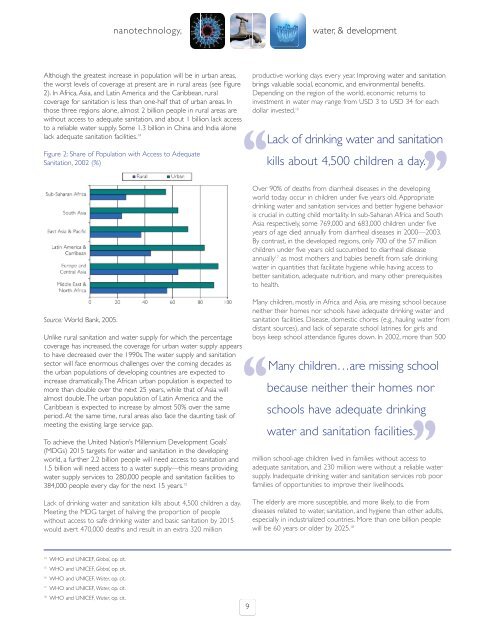Global Dialogue on Nanotechnology and the Poor ... - Nanowerk
Global Dialogue on Nanotechnology and the Poor ... - Nanowerk
Global Dialogue on Nanotechnology and the Poor ... - Nanowerk
Create successful ePaper yourself
Turn your PDF publications into a flip-book with our unique Google optimized e-Paper software.
nanotechnology,<br />
water, & development<br />
Although <strong>the</strong> greatest increase in populati<strong>on</strong> will be in urban areas,<br />
<strong>the</strong> worst levels of coverage at present are in rural areas (see Figure<br />
2). In Africa, Asia, <strong>and</strong> Latin America <strong>and</strong> <strong>the</strong> Caribbean, rural<br />
coverage for sanitati<strong>on</strong> is less than <strong>on</strong>e-half that of urban areas. In<br />
those three regi<strong>on</strong>s al<strong>on</strong>e, almost 2 billi<strong>on</strong> people in rural areas are<br />
without access to adequate sanitati<strong>on</strong>, <strong>and</strong> about 1 billi<strong>on</strong> lack access<br />
to a reliable water supply. Some 1.3 billi<strong>on</strong> in China <strong>and</strong> India al<strong>on</strong>e<br />
lack adequate sanitati<strong>on</strong> facilities. 14<br />
Figure 2: Share of Populati<strong>on</strong> with Access to Adequate<br />
Sanitati<strong>on</strong>, 2002 (%)<br />
Source: World Bank, 2005.<br />
Unlike rural sanitati<strong>on</strong> <strong>and</strong> water supply for which <strong>the</strong> percentage<br />
coverage has increased, <strong>the</strong> coverage for urban water supply appears<br />
to have decreased over <strong>the</strong> 1990s.The water supply <strong>and</strong> sanitati<strong>on</strong><br />
sector will face enormous challenges over <strong>the</strong> coming decades as<br />
<strong>the</strong> urban populati<strong>on</strong>s of developing countries are expected to<br />
increase dramatically.The African urban populati<strong>on</strong> is expected to<br />
more than double over <strong>the</strong> next 25 years, while that of Asia will<br />
almost double.The urban populati<strong>on</strong> of Latin America <strong>and</strong> <strong>the</strong><br />
Caribbean is expected to increase by almost 50% over <strong>the</strong> same<br />
period. At <strong>the</strong> same time, rural areas also face <strong>the</strong> daunting task of<br />
meeting <strong>the</strong> existing large service gap.<br />
To achieve <strong>the</strong> United Nati<strong>on</strong>’s Millennium Development Goals’<br />
(MDGs) 2015 targets for water <strong>and</strong> sanitati<strong>on</strong> in <strong>the</strong> developing<br />
world, a fur<strong>the</strong>r 2.2 billi<strong>on</strong> people will need access to sanitati<strong>on</strong> <strong>and</strong><br />
1.5 billi<strong>on</strong> will need access to a water supply—this means providing<br />
water supply services to 280,000 people <strong>and</strong> sanitati<strong>on</strong> facilities to<br />
384,000 people every day for <strong>the</strong> next 15 years. 15<br />
productive working days every year. Improving water <strong>and</strong> sanitati<strong>on</strong><br />
brings valuable social, ec<strong>on</strong>omic, <strong>and</strong> envir<strong>on</strong>mental benefits.<br />
Depending <strong>on</strong> <strong>the</strong> regi<strong>on</strong> of <strong>the</strong> world, ec<strong>on</strong>omic returns to<br />
investment in water may range from USD 3 to USD 34 for each<br />
dollar invested. 16<br />
‘‘ ’’<br />
Lack of drinking water <strong>and</strong> sanitati<strong>on</strong><br />
kills about 4,500 children a day.<br />
Over 90% of deaths from diarrheal diseases in <strong>the</strong> developing<br />
world today occur in children under five years old. Appropriate<br />
drinking water <strong>and</strong> sanitati<strong>on</strong> services <strong>and</strong> better hygiene behavior<br />
is crucial in cutting child mortality. In sub-Saharan Africa <strong>and</strong> South<br />
Asia respectively, some 769,000 <strong>and</strong> 683,000 children under five<br />
years of age died annually from diarrheal diseases in 2000—2003.<br />
By c<strong>on</strong>trast, in <strong>the</strong> developed regi<strong>on</strong>s, <strong>on</strong>ly 700 of <strong>the</strong> 57 milli<strong>on</strong><br />
children under five years old succumbed to diarrheal disease<br />
annually 17 as most mo<strong>the</strong>rs <strong>and</strong> babies benefit from safe drinking<br />
water in quantities that facilitate hygiene while having access to<br />
better sanitati<strong>on</strong>, adequate nutriti<strong>on</strong>, <strong>and</strong> many o<strong>the</strong>r prerequisites<br />
to health.<br />
Many children, mostly in Africa <strong>and</strong> Asia, are missing school because<br />
nei<strong>the</strong>r <strong>the</strong>ir homes nor schools have adequate drinking water <strong>and</strong><br />
sanitati<strong>on</strong> facilities. Disease, domestic chores (e.g., hauling water from<br />
distant sources), <strong>and</strong> lack of separate school latrines for girls <strong>and</strong><br />
boys keep school attendance figures down. In 2002, more than 500<br />
‘‘<br />
Many children…are missing school<br />
because nei<strong>the</strong>r <strong>the</strong>ir homes nor<br />
schools have adequate drinking<br />
’’<br />
water <strong>and</strong> sanitati<strong>on</strong> facilities.<br />
supply. Inadequate drinking water <strong>and</strong> sanitati<strong>on</strong> services rob poor<br />
families of opportunities to improve <strong>the</strong>ir livelihoods.<br />
milli<strong>on</strong> school-age children lived in families without access to<br />
adequate sanitati<strong>on</strong>, <strong>and</strong> 230 milli<strong>on</strong> were without a reliable water<br />
Lack of drinking water <strong>and</strong> sanitati<strong>on</strong> kills about 4,500 children a day.<br />
Meeting <strong>the</strong> MDG target of halving <strong>the</strong> proporti<strong>on</strong> of people<br />
without access to safe drinking water <strong>and</strong> basic sanitati<strong>on</strong> by 2015<br />
would avert 470,000 deaths <strong>and</strong> result in an extra 320 milli<strong>on</strong><br />
The elderly are more susceptible, <strong>and</strong> more likely, to die from<br />
diseases related to water, sanitati<strong>on</strong>, <strong>and</strong> hygiene than o<strong>the</strong>r adults,<br />
especially in industrialized countries. More than <strong>on</strong>e billi<strong>on</strong> people<br />
will be 60 years or older by 2025. 18<br />
14<br />
WHO <strong>and</strong> UNICEF, <str<strong>on</strong>g>Global</str<strong>on</strong>g>, op. cit.<br />
15<br />
WHO <strong>and</strong> UNICEF, <str<strong>on</strong>g>Global</str<strong>on</strong>g>, op. cit.<br />
16<br />
WHO <strong>and</strong> UNICEF, Water, op. cit.<br />
17<br />
WHO <strong>and</strong> UNICEF, Water, op. cit.<br />
18<br />
WHO <strong>and</strong> UNICEF, Water, op. cit.<br />
9
















